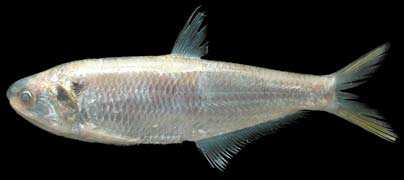| ENGRAULIDAE |

Thryssa hamiltoni, 9.8 cm SL
(photo by Seishi Kimura)
|
Thryssa hamiltoni Gray, 1835 Hamilton's Thryssa |
|
D 13-15; A 32-45 (usually 35-37) ; P1 12-13; P2 7; LGR 11-15 (usually 12-14). Body somewhat deep, compressed; abdomen with 15-20 (usually 16-19) prepelvic and 9-12 (usually 10-11) postpelvic keeled scutes, 26-31 (usually 27-29) in total number; a small predorsal spine-like scute present. Teeth in jaws small or minute, not canine-like. Posterior tip of maxilla pointed, extending to or beyond slightly posterior border of operculum. Anal fin long, its origin situated posterior to dorsal-fin base; upper pectoral-fin ray not extended as a filament. Scales cycloid; longitudinal scale rows 41-46. Color: body silvery white, grayish brown above, with a dark blotch of horizontal wavy black lines on shoulder just posterior to upper part of gill opening; dorsal, pectoral, and pelvic fins yellowish; caudal fin yellow; anal fin whitish. Size: maximum ca. 20 cm SL. Distribution: Indo-West Pacific, from Persian Gulf to northern Australia, north to Taiwan and Ogasawara Is., Japan. Remarks: occurring in inshore waters and estuaries. Marketed fresh, dried, dried-salted.(Seishi Kimura) |
|
|